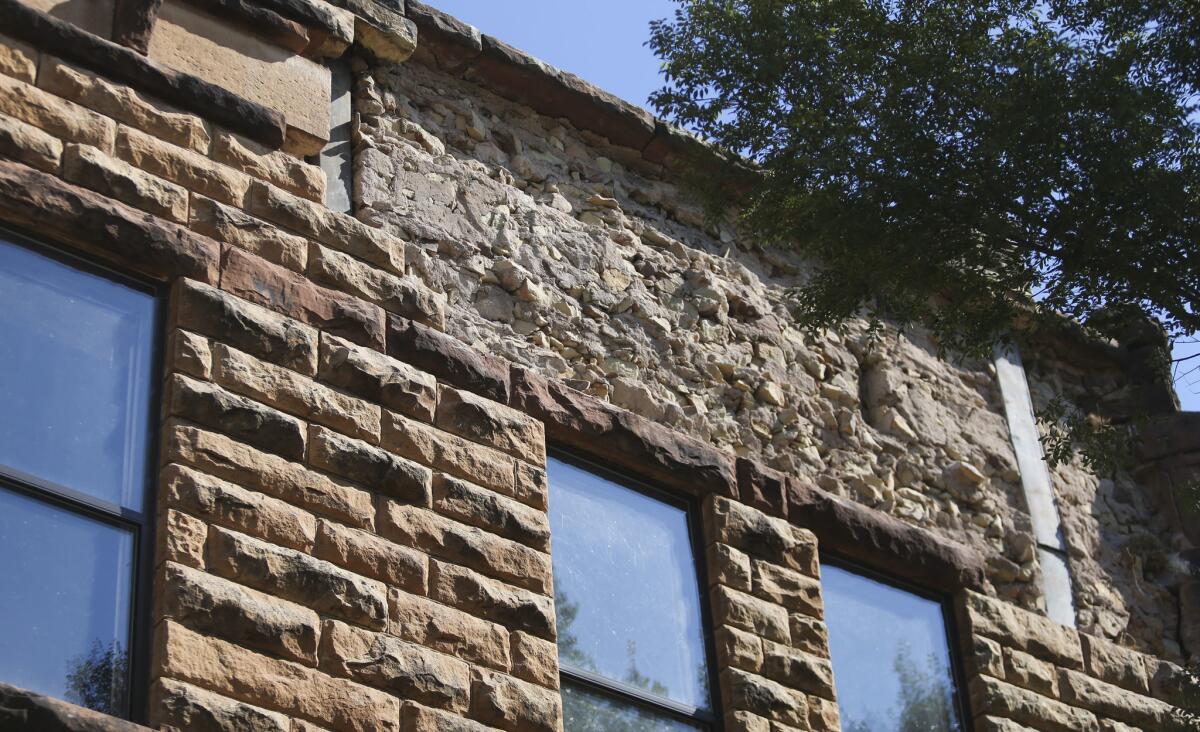Record-tying magnitude 5.6 quake in Oklahoma oil country rattles Midwest

- Share via
Reporting from houston — Oklahoma regulators ordered more than three dozen oil and gas wastewater disposal wells to shut down after a magnitude 5.6 earthquake — matching the strongest ever to hit Oklahoma — struck Saturday morning and reverberated across the Great Plains, rattling even far-off Iowa.
People took to social media to report feeling the quake not just in Iowa but Missouri, Kansas, Texas, Arkansas and Nebraska. Oklahoma Gov. Mary Fallin declared a state of emergency in Pawnee County, epicenter of the quake.
Oklahomans have grown accustomed to quakes in recent years thanks to a flurry of seismic activity linked to underground disposal of wastewater from oil and natural gas production. But people quickly noticed this was no ordinary quake for the Sooner State.
Sarah Carpenter had just awoken and was sitting on the edge of her bed when the quake hit at 7:02 a.m., its epicenter not far from her home in the town of Pawnee.
“I heard the big boom and there were like two or three after that and I thought, ‘This is not like any one we’ve ever had,’ ” said Carpenter, 64. “My house went back and forth and back and forth. I didn’t think it would ever stop. I thought, ‘I’m on a boat in an ocean.’ I could hear stuff falling in my house.… I’ve been in a skyscraper in California when they had it and that’s what it felt like. It was just rocking back and forth.”
The last magnitude 5.6 quake to hit Oklahoma struck about 70 miles south in the town of Prague in November 2011, according to the U.S. Geological Survey.
“This is the biggest one I’ve ever been around,” said Pawnee County Sheriff Mike Waters. “It was felt all around us.”
The epicenter of Saturday’s quake was about nine miles northwest of the county seat, a town of about 2,000 in north-central Oklahoma where more than a dozen older limestone-and-brick buildings were damaged and one father had to get stitches after his mantelpiece toppled on his head as he shielded his son, Waters said.
About six buildings owned by the local Pawnee tribal authority also were damaged, as were more than a dozen houses in the rural county of 16,000, Waters said.
He said the quake seemed to last more than 30 seconds, longer than recent temblors, and “that’s why we got so much more damage.” The area was shaken by a 3.2 quake earlier in the week.
“Everybody’s getting a little more used to them — but not to this magnitude,” Waters said.
Waters was at home south of Pawnee when the ground starting moving. The shaking “knocked pictures off the wall, clocks off the wall, some fans off shelves — it was pretty bad. I haven’t even got to go through my residence to see if I have any structural damage,” he said.
Carpenter inspected her home and didn’t see any damage, but worried about her pipes. When she went downtown to the antique store where she volunteers, see saw several older buildings cordoned off, their walls cracked and crumbling. The grocery store was closed. “All their food’s on the floor,” she said.

The antique store, Cornerpost, did not have any major damage, she said. Customers appeared Saturday and echoed Carpenter’s memory of the quake: “They didn’t think it was ever going to quit.”
Fallin tweeted that state crews checking potential bridge and highway damage from the quake “found very minor issues.”
“The city of Pawnee is working with insurance companies to inspect the buildings before reoccupying,” she tweeted.
Fallin also announced that the state energy regulator, the Oklahoma Corporation Commission, contacted operators of 37 disposal wells in a 725-square-mile area near the epicenter “telling them to shut down” and that the order was “based on emergency authority — this is a mandatory directive.”
“Everything within 5 miles of a 10-mile section of the fault in question is to shut down within 7 days. Everything else is to shut down within 10 days,” she tweeted.
Matt Skinner, a spokesman for the commission, said it was an “indefinite shutdown.”
“All the reductions we have done to date have been predicated on the research showing a link between Arbuckle wastewater disposal and earthquakes,” Skinner said.
The formation has long been a favored spot for wastewater disposal because of its depth and ability to soak up water. It sits just above the basement rock where most active faults lie, and where researchers have warned injecting wastewater could cause earthquakes.
The commission released a statement saying the area of concern includes 211 square miles in Osage County outside its jurisdiction. The agency has contacted federal regulators at the Environmental Protection Agency, who will “determine what action to take in that area.”
Parts of Oklahoma have become as earthquake-prone as California, experts said. Although the increase in earthquakes of magnitude 3 or greater in the state in recent years has been linked to the energy industry’s wastewater disposal, experts cautioned that it was too early to say what caused Saturday’s quake.
“For this particular one, we can’t say until we study it more,” said Jefferson Chang, interim state seismologist. “Oklahoma has had large earthquakes even before industry started up here.… It could be tectonic, it could be industry. You need more research to tell. It’s a very hot topic.”
Last year, the state-run Oklahoma Geological Survey said that it “considers it very likely” that oil and gas wastewater wells were causing the majority of the state’s earthquakes.
“If it is industry, it’s mainly wastewater disposal,” Chang said, not the drilling itself or hydraulic fracturing, known as “fracking.”
State regulators have asked Oklahoma producers to reduce wastewater disposal volumes in earthquake-prone regions of the state.
The area where the quake was centered is at the edge of a region covered by the Corporation Commission’s spring “regional earthquake response plan,” designed to reduce the number of earthquakes by decreasing wastewater injection volume by 40% compared with 2014.
Both Oklahoma and Kansas have imposed such volume limits after quakes increased in recent years, but Kansas officials acted more quickly and have seen a decrease in quakes of 2.7 or more — a 60% drop from 2014 to 2015. In Oklahoma, the frequency of quakes has continued to increase.
Carpenter was skeptical about connecting the quakes to drilling.
“I don’t think they’ve been drilling round here lately, so I have a hard time believing it’s related,” she said, blaming natural forces. “We’re on a fault line.”
Waters said he’d like to see more research into possible connections between quakes and drilling, which fuels the local economy.
“We’ve had a lot of drilling around here but the past several months it’s slowed down. As the drilling has slowed, the quakes have slowed,” he said. “Our counties rely on that, our schools, our law enforcement. But if it’s jeopardizing our citizens, we need to do something about it.”
Twitter: @mollyhf
ALSO
What Georgetown’s atonement means for the campus debate over slavery
Cornell University welcomes 12-year-old college freshman — the school’s youngest student ever
A flawed missile defense system generates $2 billion in bonuses for Boeing
UPDATES:
5 p.m.: This article was updated to report that Gov. Mary Fallin declared a state of emergency in Pawnee County.
3:35 P.M.: This article was updated with additional details and quotes from Sarah Carpenter and Mike Waters.
9:40 a.m.: This article was updated with additional details.
6:50 a.m.: This article was updated with information on the relationship between earthquake severity and property damage
This article was originally published at 5:40 a.m.
More to Read
Sign up for Essential California
The most important California stories and recommendations in your inbox every morning.
You may occasionally receive promotional content from the Los Angeles Times.











